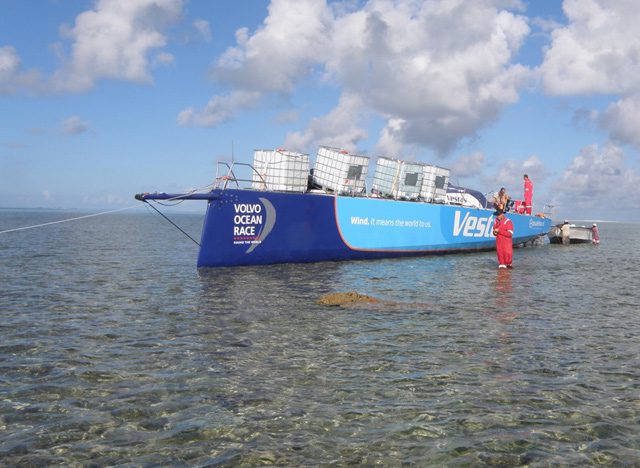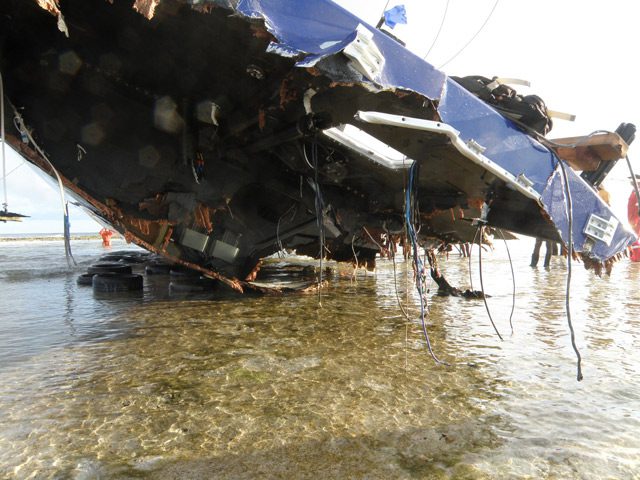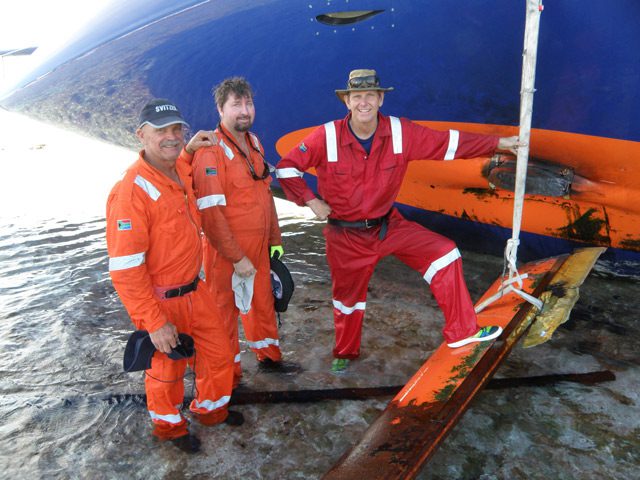Genoa Dockers Walk Out as Italian Unions Protest Against Israel
Striking dockworkers blocked access roads to the port of Genoa in northern Italy on Monday, as part of protests against Israel's offensive in Gaza.

Image (c) Subtech
Seldom does a salvage operation run as smoothly as that of the Volvo Ocean Racing yacht, “Vestas Wind”.
In a joint venture between Subtech and Svitzer, a team consisting of Neil Scott-Williams, Morgan Castle and Morne Uys of Subtech and Mike Smith and Rob Hare, veteran salvors from Svitzer was mobilized from South Africa under a Bimco Wreckhire to refloat and recover, intact, the remains of the “Vestas Wind” from the Cargados Carajos Shoal, 250nm North of Mauritius. The main objective being to salvage the deck intact to install in a new boat to be built, as that was the one item that would not be ready in time to make re-entry into the race possible.
Through the efforts of major sponsor, Maersk, arrangements were made for a container vessel, the “Jula S” to divert course and rendezvous with the salvage team during a very small window of time, on Sunday afternoon, off the Cargados Carajos Shoal. This gave the salvage team 2,5 days to inspect the vessel, confirm the method of salvage and then execute on the plan to be floating and ready for the “Jula S” or risk missing the opportunity and scuttling any chance of Team Vestas Wind re-entering the race.
In Mauritius, the Subtech/Svitzer team joined forces with Team Vestas Wind in the form of team manager, Neil Cox, “Vestas Wind” Skipper, Chris Nicolson and shore skipper Tom Kif. Local Support in the form of Raphael Fishing, concession holders for the Cargados Carajos Shoals, through general manager Alain Langlois and his very capable righthand man, Julien Merven closed the loop on the most competent team for the job one could possibly wish for.
Due to the extremely remote position of the casualty, a plan combining the salvage experience of Subtech/Svitzer, vessel knowledge and understanding of Team Vestas together with the local knowledge of Raphael Fishing was formulated. The plan catered for almost any eventuality and outcome ranging from refloat and rendezvous with the “Jula S” through to cutting her up on site for disposal in Mauritius and a few others in between.

The three primary challenges identified were cutting of the keel (650 x 150mm forged tool steel), removing the rigging (due to the instability and risk factor it introduced) and re-establishment of sufficient ballast and buoyancy to refloat in a minimum of 40cm of water. Confirmation of the planned methodology for each process could only be made on day 1, during the first visual inspection. Planning the equipment for this operation offered some challenges, nothing could be left to chance, once we were out there we only had one shot at it. To re-mobilize for any revised solution would almost certainly result in a wreck removal and no chance of re-entry to the race.
Equipment and personnel were mobilized on board the Raphael Fishing charter yacht, “Gryphon,” a 90-foot liveaboard normally used for birding and fly fishing charters to the area.
24 hours after sailing from Port Louis the team awakened to what any water loving tourist would term paradise – crystal clear water, white sand, coral reef, teeming sea life, birds so unaccustomed to man that you could walk right up to them on their nests with their chicks without them taking flight.
On the horizon in the distance you could make out the tilted silhouette of the stranded “Vestas Wind”
Shortly after arrival, the true might of Raphael Fishing became evident when a flotilla of 6m skiffs manned by a strong team of local fishermen, arrived alongside the Gryphon and it was a matter of minutes before the first team consisting of Neil Scott-Williams, Neil Cox, Chris Nicholson and MTD Surveyor, James Hammond were on their way to the casualty to make the tough decisions and sense test weeks of joint deliberation. Close behind them followed the balance of the team and first wave of equipment.
At first inspection it was noted that the entire starboard quarter was missing from the transom through to the forward keel bulkhead but Plan A seemed very feasible and the teams kicked into immediate action with Subtech/Svitzer tackling the keel and re-establishment of watertight integrity of the hull, Team Vestas preparing deck equipment and rigging and Raphael Fishing supporting all activities through their team of able and willing mariners lead by the indomitable Julien Merven.

Very quickly it became apparent that the operation would be very tidally dependent with the teams unable to work over the high tide. Equipment was nevertheless set up and the primary operation of cutting the keel tested. Due to the difficulty in cutting forged tool steel, Subtech/ Svitzer elected to use Broco thermic lances and from the first strike it was apparent that it was the right decision. Using the remainder of the tidal window, all systems were tested and proven functional before the team demobilized for the high tide.
During the next 2 low tides the keel was cut 80%, a 4 point anchor spread established, cross hauls on the mast established to create stability during the cut, buoyancy introduced to the missing starboard quarter and internal bulkheads re-established to allow maximum buoyancy. We were doing well.
On the next high tide, lunch was disturbed by a radio call to say the vessel was moving and that the scaffold work platforms were being threatened. Teams jumped into action and on arrival found the tide to be significantly higher that expected and that the vessel had indeed moved about 3m but that the 4 point mooring was holding strong and true. She was safe but it was clear that on the following low tide we had to refloat and that included completing the keel cut, lowering the mast and rigging and ensuring she was ballasted correctly and watertight, it was going to be a long shift working late into the night, not ideal.
Once again, only exceptional effort and competence of all parties involved ensured that by the turn of the tide, all was ready for the refloat. Now as any salvor knows, when working to beat a tide it seems to come in like lighting, but when waiting for the tide, it seems not to move. With all tasks complete, the waiting started.
We all expected some dramatic banging on the reef as the waves started to roll in, but nothing, just gentle movement. Morgan decided to come up on the stern line and pay out on the bow and all of a sudden we were moving. In the pitch black of a moonless night, all hands were required to navigate the yacht between the exposed coral heads all around. But within a couple of hours we were floating safely in calm water out of the reach of the breaking waves. Perfect trim and shallow draft… more good luck than good judgement but making for a very happy salvage team.
Once again, a 4 point anchor system was established and the yacht secured for the remainder of the night with a caretaker team looking after her till morning.
Morning found her floating beautifully where we left her and team mobilized to recover all remaining equipment from the reef including keel, mast and all equipment used for the salvage.
With the incoming tide, “Vestas Wind was towed out and brought alongside the “Gryphon” out on her anchorage to stand by for the arrival of the “Jula S”
Not having charts for the area, “Jula S” was concerned about the approach but fortunately the captain of the “Gryphon”, Roger Addisson, was an ex Mauritian Pilot of many years experience in Mauritius and the Cargados Carajos Shoal areas and was able to give reassurance regarding the approach and provide the vessel with the charts enabling them to approach within one mile of the “Gryphon” thereby making the job infinitely easier.
Once “Jula S” was at anchor, the “Vestas Wind” was towed across by Gabby, Raphael Fishing’s senior man on the islands, and handed over to the vessel. Here, within the space of an hour, through the coordinated efforts of all parties, the “Vestas Wind” was securely lashed in place and the “Jula S” was able to sail, only 15 minutes later than scheduled.
Not often does an operation run as smoothly as this and one needs to recognize the efforts of all parties mentioned above, meticulous planning and robust negotiation bringing a wide range of contributory skills into play was the main factor but one cannot ignore the one ingredient that so often makes such a big difference to any outcome, Teamwork.

Sign up for gCaptain’s newsletter and never miss an update

Subscribe to gCaptain Daily and stay informed with the latest global maritime and offshore news
Essential news coupled with the finest maritime content sourced from across the globe.
Sign Up